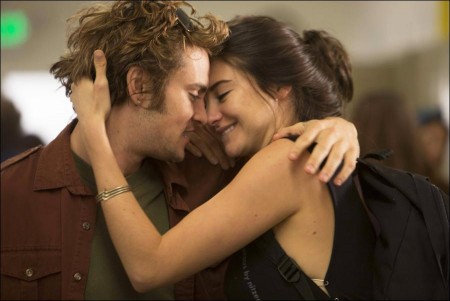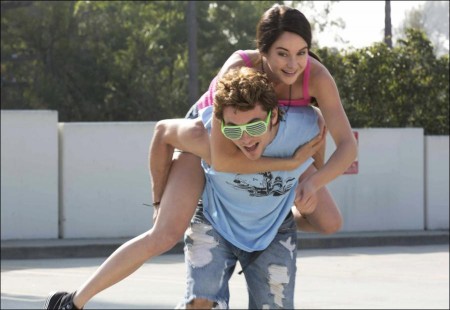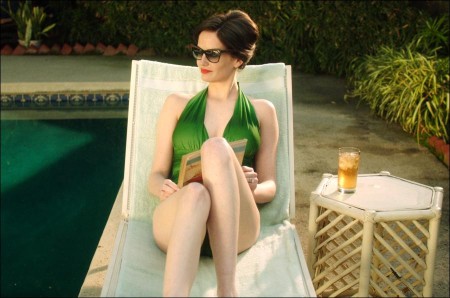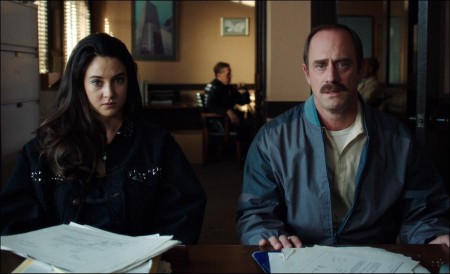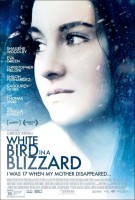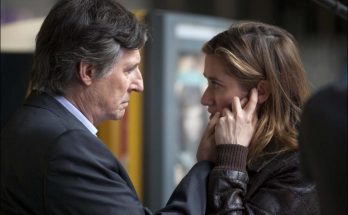Taglines: I was 17 when my mother is dissapeared.
Kat Connors (Shailene Woodley) is 17 years old when her perfect homemaker mother, Eve (Eva Green), a beautiful, enigmatic, and haunted woman, disappears – just as Kat is discovering and relishing her newfound sexuality. Having lived for so long in a stifled, emotionally repressed household, she barely registers her mother’s absence and certainly doesn’t blame her doormat of a father, Brock (Christopher Meloni), for the loss. In fact, it’s almost a relief. But as time passes, Kat begins to come to grips with how deeply Eve’s disappearance has affected her. Returning home on a break from college, she finds herself confronted with the truth about her mother’s departure, and her own denial about the events surrounding it…
Q & A With Gregg Araki
White Bird in a Blizzard is adapted from a novel by Laura Kasischke. What made you decide to make this story into a movie?
Gregg Araki: A producer friend and collaborator of mine, Sebastien Lemercier, recommended the book which I read and fell in love with. I was instantly struck by the novel’s lyrical and poetic nature. It really haunted me and reminded me of what I had liked about Scott Heim’s novel Mysterious Skin: softness and beauty within the violence.
What was it about the book that moved you the most?
Gregg Araki: It’s difficult to put into words but you instinctively know what movies you need to make. Laura’s storytelling style is impressionistic and also very visual and cinematic so it lends itself perfectly to the filmmaking process. The feminist aspect of her viewpoint also appealed to me as I have always been heavily influenced by feminist film theory.
White Bird is the story of a young woman, Kat Connors, who is taking her first steps into her own sexuality just as her world is turned upside down by the sudden disappearance of her mother. But the novel isn’t a generic suspense thriller – it’s more measured, introspective, a beautiful and haunting portrait of a broken American family. Kat’s mother, Eve, is an archetypal suburban housewife – a woman whose place in the world has been prescribed for her by society. She dutifully manages her household but it slowly turns into a prison. Eva Green, who plays Eve, and I were both really compelled and fascinated by this tragic component of her character.
What did you change in the story to make it your own?
Gregg Araki: Adapting the novel for the screen, I started by moving the story from Ohio to Loma Linda, California, a suburb near L.A. which is similar to the one I grew up in. It’s helpful for me to have inside knowledge of a location and its atmosphere, in order to create the world of the film.
The book is divided into four distinct chapters chronicling the years between 1986 to 1989, for the film we’ve shifted a bit later to the late eighties/early nineties – a period that, culturally and especially musically, has always fascinated me. As anyone familiar with my movies knows, the music of that era which is used in the film – Depeche Mode, New Order, The Cure, Cocteau Twins, etc. – that music was a huge influence and inspiration for me as a young artist, so the film pays homage to that.
What was involved in adapting the novel?
Gregg Araki: A filmmaker has the advantage of being able to tell a story through images – and Laura’s novel was full of beautiful, cinematic imagery to start with. I always work with a storyboards so I can put the images which are playing in my head onto paper for others – the crew, the actors, etc. – to see.
It helps me make the imaginary real. The world that Laura created was rich and very vivid – the snow in Kat’s dreams, the gloomy interior of the Connors house, it was all there in the book. I always find it’s easier to work from something that exists, because the story, characters and images are already there. All you have to do is hone and sculpt them into a 90 minute format.
This is your second book adaptation, after Mysterious Skin. Both films feature a certain softness, an intentional romanticism. It’s almost as though adapting someone else’s work tames your style…
Gregg Araki: You could look at it that way I suppose. But at the same time, both films explore my usual stylistic and thematic concerns – dreams and the surreal, sexual coming of age, people who are outsiders in society, etc. For me, adapting someone else’s work usually means finding a voice that I empathize with, which really strikes a chord in me. Scott Heim and Laura are both clear examples of this.
Then, in making the book into a film, it’s about staying true to that voice while enhancing it with my own authorial vision. With a film like Kaboom or Doom Generation, which are original screenplays I wrote, those films are more like my imagination running wild, not in service of another author’s voice and point of view. Despite their seeming difference in tone and surface, the films which are my original ideas and those I adapt from other sources fit together.
The narrative structure relies heavily on Kat’s dreams. How did you work with these dreams?
Gregg Araki: The dreams Kat has of her mother lost in the snow give us an insight into the emotional bond between them as well as illuminating what is going on inside Kat’s head. My films have always been influenced by surrealism and filmmakers like David Lynch so the way Laura utilizes dreams in the book definitely appealed to me. It really gave me a pathway into the story.
White Bird In A Blizzard unfolds almost entirely from Kat’s perspective – it’s told from a very feminine point of view…
Gregg Araki: It’s not the first time I’ve made a movie centered on a female protagonist – Smiley Face (2007) and even in The Doom Generation (1995), a significant part of the action is seen through Amy Blue’s eyes. From my days in film school, I’ve always been interested in the feminist perspective which is why Laura’s sensibility is such a good fit for me.
This film also seems to take a different approach to one of your favorite subjects – adolescence.
Gregg Araki: Adolescence is a time of change and transition, where nothing is stable or certain, and teenagers live a life that is a big question mark – so naturally they make compelling dramatic subjects. However, I’m in my fifties and not particularly interested in dragging out my adolescence in my movies. Throughout all my films, my perspective of this period of life has changed significantly over the years.
In White Bird, the crazy rock ‘n’ roll side of adolescence is virtually non-existent. Instead, the film focuses on Kat’s troubled and dysfunctional family and as a result it’s much quieter and more serious. There’s a big difference between this movie and Doom Generation, made 20 years ago. While Doom is very wild and chaotic, White Bird In A Blizzard is more controlled, introspective, classical almost in structure and tone.
There are some characters, like Kat’s close friends, who seem to represent the outcasts of the world: the overweight Afro- American, the gay best friend…
Gregg Araki: In the book, Kat’s friends were two white girls. My movies have always been about outsiders, those who don’t really fit into mainstream American society. That’s why I changed these characters as I envisioned Kat and her friends as misfits who create a world unto themselves. They are perfectly content living outside of the norm, apart from the middle of the road “popular” kids, because they have each other.
You purposefully set the film in the late Eighties. How does this context impact the tragedy that befalls this family?
Gregg Araki: Women like Eve Connors grew up in the Fifties and Sixties – a time before the major societal and cultural developments of women’s rights and feminism. These women were taught from a young age that their place was in the home. Eva Green and I discussed this idea at length when we were talking about Eve. Someone like Eve would have been greatly influenced by the icons of that period: Jackie Kennedy, Elizabeth Taylor, and all of Hitchcock’s heroines who were the incarnation of the feminine ideal in their time.
These women would have all been role models for Eve, so she lives to project the image of the perfect wife and mother. One of my favorite scenes is the montage of an impeccably dressed Eve cleaning her house – which we intentionally shot and lit so it looks like one of those old TV commercials glorifying the happy, perfect housewife.
You mentioned Hitchcock, who wasn’t known for being a feminist. Kat’s mother seems more like a character from a Douglas Sirk melodrama…
Gregg Araki: Sirk is definitely a reference. And I guess you could say Hitchcock is almost more like the “anti” reference – since his women are systematically trapped, victimized, and even murdered as they are idealized and put on a pedestal. With White Bird, I wanted to show how the “paradise” of suburban America could turn into a sort of living hell. My set designer, when he first read the script, said: “Wow, that’s the story of my family!” [laughs]
The dilemma of the Connors family, beyond the story’s more extreme dramatic elements, is actually a pretty common one. The foundation of the American Dream is that everyone is supposed to have the same dream but the reality is that there is a lot of unhappiness, a lot of secrets and lies and hidden tragedy. Laura’s novel really eloquently points out that the American Dream doesn’t necessarily work for everyone.
It reminded me in a way of American Beauty (Sam Mendes – 1999) and The Ice Storm (Ang Lee – 1997), portraits of the American middle class that explore the darkness lurking beneath the seemingly perfect facade. Hollywood doesn’t really make that kind of movie anymore.
Kat is played by Shailene Woodley who has recently achieved international stardom as the heroine in the teenage saga Divergent (Neil Burger – 2014). Was this iconic element helpful to you?
Gregg Araki: I first discovered Shai through her heartbreaking performance in The Descendants (Alexander Payne – 2011). Coincidentally, she was a big fan of Mysterious Skin and I’ve known her manager, Nils Larsen, for years. He insisted that I meet Shai and we hit it off instantly. This was years before Divergent came along. She read the script for White Bird, loved it, and immediately signed on.
Shai actually reminds me a lot of Joe Gordon Levitt, who I worked with on Mysterious Skin. They are both incredibly talented and creative individuals who take their art very seriously – they’re not in it for fame or money or any of the bullshit. They both also have really great parents so they’re more centered and secure in themselves than some young actors who don’t have that kind of solid upbringing.
The role of Eve is a departure for Eva Green as she portrays a character who is significantly older than she is in real life. It’s a role unlike any we’ve seen her play before.
Gregg Araki: Eva’s performance in the movie just blew me away. Because the Eve character ages from early 30s to 40s, we debated casting an older actress and making her look younger with makeup and effects but I couldn’t get Eva out of my mind. I’ve been a huge fan of hers since The Dreamers (Bernardo Bertolucci –2003) and I was so excited for the chance to work with her. She and I were both very wary however of using prosthetics and “old age” makeup to make Eve look like the weary, older housewife she is in the film’s later half because that always looks so fake and terrible.
In the end, we barely touched her face, the makeup artist just very subtly enhanced what was already there. The rest is all Eva – she just miraculously became this entirely different person, her posture, body language, her very essence changed. She just kind of withered away. When I first saw her in character, wearing that sad grey sweater, lurking in the doorway, I was stunned because in real life Eva is one of the most gorgeous, radiant people I’ve ever met. She is literally like Marlene Dietrich or Greta Garbo, this otherworldly kind of presence.
In fact, Eva was only 32 when we shot the film, which is funny, because Shiloh Fernandez, the actor who plays Phil, Kat’s teenage boyfriend, was like 27 at the time; they could date in real life and no one would bat an eye. But the scene where the two of them are flirting is genuinely unnerving and creepy because they are both so skilled at making us believe those characters. The entire cast – Shai, Eva, Shiloh, Chris Meloni, Gabourey Sidibe, Tom Jane… I just feel incredibly blessed for the opportunity to work with such an amazing ensemble of actors. It really was like a dream come true.
White Bird in a Blizzard
Directed by: Gregg Araki
Starring: Shailene Woodley, Eva Green, Christopher Meloni, Shiloh Fernandez, Gabourey Sidibe, Thomas Jane
Screenplay by: Gregg Araki, Laura Kasischke
Production Design by: Todd Fjelsted
Cinematography by: Sandra Valde-Hansen
Costume Design by; Mairi Chisholm
Set Decoration by: Ryan Watson
Music by: Harold Budd, Robin Guthrie
MPAA Rating: R for sexual content / nudity, language and some drug use.
Studio: Magnolia Pictures
Release Date: October 24, 2014
Visits: 63
